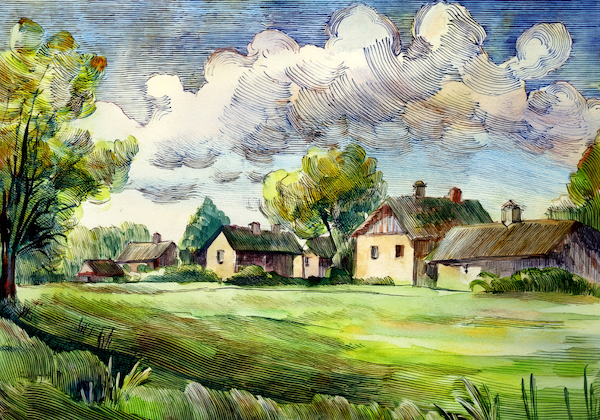Table of Contents
I recently designed a course on genre in film. The theme for the first iteration of the class is folk horror—a genre where villages frequently appear as both settings and symbolic spaces where forgotten traditions persist.

What Is a Village?
In the UK, where folk horror came into its own, a village is a compact settlement of houses with a public building like a church, often sited for agriculture. Medieval villages were usually organized around a village green and land would have been farmed communally. This is where the phrase "the commons" comes from—a common place, both physically and conceptually, that belonged to everyone.
The concept of the "village green" as a common place mirrors the idea of a "commonplace book"—a personal collection of important ideas, quotes, and knowledge gathered in one location. Both represent shared repositories of community wisdom, whether physical (the green) or textual (the commonplace book).
Unfortunately, after the 1600s, the commons were enclosed and private property became the organizing principle of farming and life:
One of the major changes that led to the increased complexity in the form of the British village was the movement away from communal open-field farming (common in medieval times) to the enclosure of land into regular fields which occurred in most of Britain between 1600 and 1800. This had a huge effect on settlements as new patterns of farm holdings developed away from the village centre. In many cases the village structure was weakened as the farming population moved away from the centres of population.
Villages in Folk Horror
In folk horror, villages often function as:
Time Capsules
The village frequently represents a space where time has moved differently, preserving beliefs and practices that have been abandoned by urban society:
- The Wicker Man (1973, UK)
- Children of the Corn (1984, US)
- Apostle (2018, UK)
Communities of Shared Knowledge
Villages maintain collective memories and communal traditions that can be both protective and dangerous:
- The White Reindeer (1952, Finland)
- The Dark Secret of Harvest Home (1978, US)
- Midsommar (2019, US/Sweden)
Contested Spaces
Many folk horror films explore the tension between communal traditions (the commons) and more modern, individualistic values:
- Witchfinder General (1968, UK)
- The Medium (2021, Thailand)
The Lost Commons
The concept of "the commons" is particularly significant in folk horror. The enclosure movement of the 16th-18th centuries in Britain transformed communal land into private property, fundamentally changing rural social structures.
The Diggers, a 17th-century radical Protestant group, resisted these enclosures by establishing communes on unused land. Their defense of the commons could be seen as an early form of agrarian anarchism—a resistance to the privatization that was destroying communal life in favor of capitalism.
Folk horror often mourns or examines this loss of communal living while simultaneously expressing anxiety about the darker aspects of tight-knit communities. The village becomes both utopian and dystopian—a space where people care for each other collectively, but also where conformity is enforced through tradition and ritual.
This note is part of a series exploring folk horror in cinema. I'm developing these themes for a film genre course focusing on folk horror.